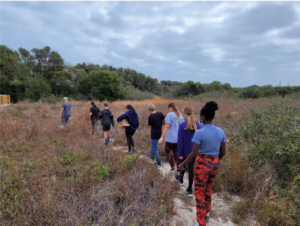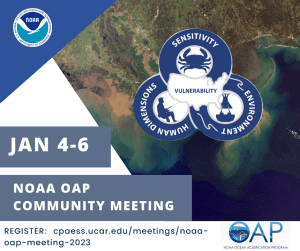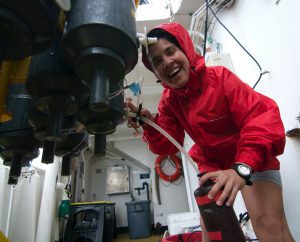
Pier2Peer graduates 20 mentees to build capacity toward addressing ocean acidification
Twenty Pier2Peer mentee graduates, representing 17 countries, join the global professional community for ocean acidification monitoring and research.

Twenty Pier2Peer mentee graduates, representing 17 countries, join the global professional community for ocean acidification monitoring and research.

Join MACAN and NOAA OAP for the biennial state-of-the-science meeting and technical assistance workshop July 15-17 in Edgewater, Maryland.

Funding opportunity open with the Delaware Bay Watershed Education and Training (B-WET) program. to support environmental literacy programs.

NOAA’s Ocean Acidification Program (OAP) announces the FY24 Education Mini-grant Program awards.
NOAA”s Ocean Acidification Program (OAP) advances ocean acidification science, education and outreach. The needs of audiences around the nation grows with the advancement of our knowledge. We will assess stakeholder needs nationwide via listening sessions to identify gaps, priorities, and the ways in which we can support people impacted by

COMMUNITY OF PRACTICE, GOA-ON HUB, AND COASTAL ACIDIFICATION NETWORK There is a significant need to strengthen capacity for research, monitoring, and adaptive solutions for ocean acidification resilience and associated multi-stressors in the Caribbean region. The Caribbean Ocean Acidification Community of Practice (CoP) endeavors to explore the impacts of ocean acidification

NOAA OAP convenes community meeting in San Diego, CA!
Every three years, the NOAA Ocean Acidification Program convenes researchers, communicators and others in the OA community for a meeting to discuss and share the latest research and future needs and directions. We want your participation! Registration is free.
Meeting Goals
The Bigelow Center for Seafood Solutions is excited to announce the request for applications for funding to support pilot studies relevant to the Interagency Working Group on Research for Farming of Seaweeds and Seagrasses, chaired by the USDA’s Agricultural Research Service and operating in partnership with the Bigelow Laboratory for

Puerto Rico is home to vibrant coral reef ecosystems that support a diversity of marine life and livelihoods. Join Melissa Melendez, University of Hawai’i Manoa and Lisamarie Carrubba, NOAA Fisheries’ Office of Protected Resources, as they share our journey in creating Spanish-language videos (with English subtitles) about ocean acidification, its

In this webinar, Beth Turner of NOAA National Ocean Service, National Centers for Coastal Ocean Science, shares priorities and capacities of citizen science groups for acidification measurements in the Northeast US, reactions to the provided training, lessons gained and how we might engage in future coordinated monitoring efforts.

Understanding seasonal changes in ocean acidification in Alaskan waters and the potential impacts to the multi-billion-dollar fishery sector is a main priority. Through work funded by NOAA’s Ocean Acidification Program, the Pacific Marine Environmental Laboratory developed a model capable of depicting past ocean chemistry conditions for the Bering Sea and is now testing the ability of this model to forecast future conditions. This model is being used to develop an ocean acidification indicator provided to fisheries managers in the annual NOAA Eastern Bering Sea Ecosystem Status Report.
The NOAA Ocean Acidification Program (OAP) works to prepare society to adapt to the consequences of ocean acidification and conserve marine ecosystems as acidification occurs. Learn more about the human connections and adaptation strategies from these efforts.
Adaptation approaches fostered by the OAP include:

Using models and research to understand the sensitivity of organisms and ecosystems to ocean acidification to make predictions about the future, allowing communities and industries to prepare

Using these models and predictions as tools to facilitate management strategies that will protect marine resources and communities from future changes

Developing innovative tools to help monitor ocean acidification and mitigate changing ocean chemistry locally
Drive fuel-efficient vehicles or choose public transportation. Choose your bike or walk! Don't sit idle for more than 30 seconds. Keep your tires properly inflated.
Eat local- this helps cut down on production and transport! Reduce your meat and dairy. Compost to avoid food waste ending up in the landfill
Make energy-efficient choices for your appliances and lighting. Heat and cool efficiently! Change your air filters and program your thermostat, seal and insulate your home, and support clean energy sources
Reduce your use of fertilizers, Improve sewage treatment and run off, and Protect and restore coastal habitats
You've taken the first step to learn more about ocean acidification - why not spread this knowledge to your community?
Every community has their unique culture, economy and ecology and what’s at stake from ocean acidification may be different depending on where you live. As a community member, you can take a larger role in educating the public about ocean acidification. Creating awareness is the first step to taking action. As communities gain traction, neighboring regions that share marine resources can build larger coalitions to address ocean acidification. Here are some ideas to get started: